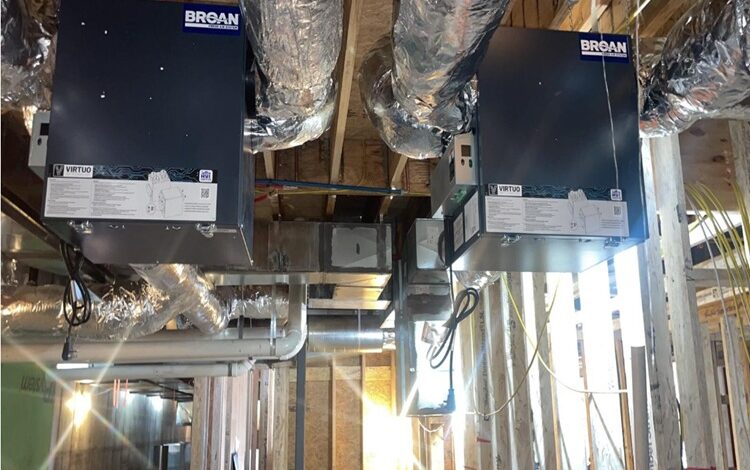How Building Automation Systems Boost HVAC Efficiency and Comfort

Think about entering a building where the temperature is always good, never too hot or cold. The air always feels clean, even if many people are there. It’s not magic or a coincidence. Behind the scenes, innovative systems work quietly to keep things comfortable while using energy wisely. These systems don’t just help save money; they also make life easier for everyone who works or lives in the building.
One of the most well-known players in making this possible is the Building Automation System (BAS). These systems are like the brain of the building, helping heating and cooling systems do their job better. They learn, adjust, and even predict what’s needed before anyone notices a change. Partner with HVAC Services in Kitchener experts to turn your building into a smart, energy-saving space by integrating BAS for consistent comfort and cleaner air.
In this blog, we will explore how Building Automation Systems are changing how HVAC systems work—and how they help create spaces that feel good while using energy more efficiently.
What Is a Building Automation System (BAS)?
A Building Automation System (BAS) is an innovative system that helps manage and control different parts of a building, such as heating, cooling, lighting, and ventilation. It works like the brain of the building, helping everything run smoothly and efficiently without constant manual control.
Consider BAS as a central control room connecting all primary systems in a building. It collects information from different areas and automatically adjusts to keep the building comfortable and save energy. Here’s what a BAS usually controls:
- HVAC Systems: like air conditioners, heaters, and fans
- Lighting: turning lights on/off based on time or room use
- Air Quality: checking and improving fresh air inside the building
- Energy Use: reducing waste by turning off things not in use
This system helps business owners reduce costs, maintain comfort for employees and visitors, and avoid equipment damage by identifying problems early. It’s a smart way to make buildings run better without extra effort.
Top 5 Benefits of BAS Integration with HVAC Systems
When you connect building control systems to HVAC systems, it actually helps businesses. Buildings work better, cost less to run, and are more comfortable for everyone. With BAS, HVAC systems can be run automatically. This ensures that energy is used well and the indoor environment stays comfortable. Below are the key benefits of integrating BAS with HVAC systems.
-
Reduce Energy Consumption
BAS helps reduce energy waste by adjusting HVAC settings based on real-time needs. For example, the system will reduce heating or cooling if the building is unoccupied. This ensures that energy is only used when necessary, reducing utility bills.
- Reduces energy use during off-hours
- Prevents unnecessary heating or cooling
- This leads to lower energy costs
BAS changes settings automatically, so HVAC systems work only when needed. This helps buildings save energy. If you’re looking to lower energy bills and make your HVAC system work smarter, contact the Heating and Cooling in Brantford team.
-
Customizable Settings
BAS allows for easy customization of temperature and air quality settings across different areas of the building. Offices, meeting rooms, and other zones can each have their settings. This ensures energy isn’t wasted on unoccupied spaces while occupants remain comfortable.
- Set different temperatures for various zones
- Adapt climate control to individual preferences
- Save energy by targeting specific areas
Customizing settings makes the building more efficient, allowing businesses to create a comfortable working environment while saving energy.
-
Automatic Scheduling
Another benefit of BAS integration with HVAC is automatic scheduling. HVAC systems can be set to run during specific hours, such as before employees arrive and after they leave, preventing unnecessary energy use.
- Set HVAC to operate during business hours only
- Avoid manual adjustments
- Optimize energy use by operating only when needed
This automatic scheduling ensures your HVAC systems run efficiently without wasting energy after hours or during periods of low demand.
-
Consistent Air Quality
Maintaining a healthy indoor environment is easier with BAS. The system continuously monitors air quality, adjusting ventilation and filtration to ensure fresh air throughout the building. If air quality drops, BAS automatically activates air purifiers or adjusts ventilation rates.
- Monitors air quality in real-time
- Adjusts ventilation and air filtration automatically
- It helps reduce pollutants and allergens
By maintaining consistent air quality, BAS ensures a healthier atmosphere for building occupants.
-
Early Problem Alerts
BAS systems can detect HVAC malfunctions early and send alerts. This helps address issues before they become significant problems, reducing the risk of expensive repairs or system downtime.
- Sends alerts when issues are detected
- It helps prevent major breakdowns
- Reduces costly emergency repairs
Early problem detection ensures that HVAC systems remain in optimal condition, minimizing the need for unexpected repairs.
5 Ways BAS Enhances HVAC Efficiency and Occupant Comfort
Adding a building automation system to an HVAC system helps use less energy. It also makes people in the building feel better. This combination leads to better working conditions and lower energy bills. Here are five easy-to-understand ways BAS makes HVAC systems more effective and user-friendly.
-
Real-Time Monitoring and Control
BAS monitors the HVAC system in real-time, checking temperature, airflow, and equipment performance. It adjusts settings automatically when something changes—like a crowded room or a sudden weather shift outside. This quick response keeps the indoor environment comfortable without wasting energy.
- Detects changes and adjusts instantly
- Keeps rooms at the right temperature all-day
- Reduces energy use during quiet hours
It ensures that the building stays comfortable while the system only works as much as needed.
-
Improved Indoor Air Quality
BAS helps maintain cleaner and fresher indoor air. It manages ventilation systems by bringing in the right amount of fresh air and controlling humidity. It also reduces dust, allergens, and stale air, which can affect health and focus.
- Balances airflow to keep air fresh
- Removes unwanted indoor pollutants
- Controls moisture levels
This makes the building healthier and more pleasant for everyone inside.
-
Zoned Temperature Control
With BAS, different parts of the building can be set to different temperatures. For example, meeting rooms, offices, and storage areas can each have their settings. This avoids wasting energy on empty rooms and keeps people comfortable where they are.
- Set temperatures for different zones
- Use less energy in rarely used spaces
- Keep occupants happy in their specific areas
It allows more control over comfort while lowering unnecessary heating or cooling.
-
Remote Access and Adjustments
A great thing about BAS is that you can control HVAC systems using your phone or computer. This means facility managers don’t have to be on-site to check or update the system, saving time and effort.
- Make changes without being in the building
- Get alerts if something goes wrong
- Monitor performance from anywhere
It adds a layer of convenience and control, especially for larger or multi-location buildings.
-
Better Occupant Productivity
When the building stays at a steady temperature, and the air feels clean, people feel better and work better. BAS creates a comfortable space that reduces distractions caused by stuffy air, heat, or cold spots.
- Reduces discomfort and health complaints
- Supports focus and concentration
- Creates a more enjoyable work setting
This comfort leads to better work performance and a more positive atmosphere.
In Conclusion
Building Automation Systems (BAS) have completely changed how HVAC systems work by making them more innovative, energy-efficient, and better at keeping people comfortable. Building automation systems lets businesses manage temperature, improve air quality, and allow access from anywhere. This helps them make buildings more comfortable, use less energy, and spend less money. It’s a smart step for any building looking to stay comfortable, efficient, and ready for the future.



